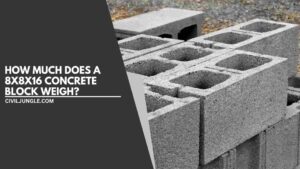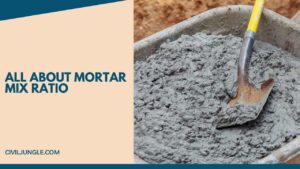What Is Fly Ash Bricks? Fly ash bricks are a building component in civil engineering; mostly, they are masonry material. Generally, class C and class F-fly ash, sand/stone dust and water is the ingredient of fly ash … [Read more...]
Exploring the Diversity of Plaster Types and Their Applications
Types of Plaster Different Types of Plaster are used for coating, protecting, and decorating internal walls and ceilings. There is often uncertainty around the dissimilarity between render and plaster and in which position they … [Read more...]
How to Remove Paint from Concrete Without Chemicals | Procedure to Remove Paint from the Concrete Surface | How to Get Spray Paint Off Concrete
Instruction of Remove Paint from Concrete Concrete is a widely used building material in the construction industry. Concrete is used in the construction of every structural element. The Concrete surface has a natural light … [Read more...]
How Much Does a 8x8x16 Concrete Block Weigh?
How Much Does an 8x8x16 Concrete Block Weigh? 8x8x16 concrete block is designed for various products. It has a compressive strength of about 1800 PSI and weighs 28lb. It will also discuss the difference between concrete and … [Read more...]
Understanding Cinder Block Weights: Sizes and Variations
How Much Does Cinder Block Weight? In civil engineering, as we know cinder blocks are concrete masonry or CMU units. Cinder blocks are rectangular shape-like blocks. Cinder blocks are available in various sizes and weights … [Read more...]
Soil Hydrometer | What Does a Hydrometer Measure | How Does a Soil Hydrometer Work | How to Read Hydrometer | Use a Hydrometer | Advantages & Disadvantages of Hydrometer
Soil Hydrometer: A hydrometer is an instrument that is utilized to gauge the general thickness of a fluid. Essentially, what is a hydrometer used for is to measure the density of liquids. A hydrometer is made of glass and … [Read more...]
What Is the AASHTO Classification System | AASHTO Classification System Procedures
Introduction of AASHTO Although the textural classification of soil is relatively simple, it is based entirely on the particle-size distribution. The soil classification table and group index formula AASHTO are essential tools … [Read more...]
Detached Garage Ideas and Design Inspiration
Detached Garage Ideas Many of us need more room sometimes. Renting a storage space can fulfill the job but every time you use it, it feels like a pain in the ass. Every time you will have to drive the cars there. To avoid … [Read more...]
What Is Grouting | Types of Grouting | Advantage of Grouting | Types of Grout for Ceramic Tile
What Is Grouting? Grout is usually a mixture of cement, sand, and water or chemicals that are used to fill gaps, often referred to as grouting meaning in construction. They are used in repairing concrete cracks, filling seams … [Read more...]
Introduction of Bamboo | Advantages & Disadvantages of Bamboo | Bamboo Uses in Construction | Properties of Bamboo as a Construction Material | Bamboo Architecture
Introduction of Bamboo Bamboo is one of the oldest and traditional bamboo construction materials used in different construction activities. The bamboos strength it is more as compared to other construction material. Bamboo … [Read more...]
Clear Cover for Slab, Beam, Column, Staircase and Footing
Translucent Covering for Slabs, Beams, Columns, Stairs, and Floors covers slabs, beams, columns, stairs, and foundations. Generally, a little cover is taken as 15mm to 75 mm for RCC work. The Buildings consist of structural … [Read more...]
Understanding Mortar Mix Ratios: A Guide to Choosing the Right Blend
Introduction of Mortar Mix Ratio Mortal is necessary when working with brickwork, metal, and block. In its basic form, mortal is made with a blender and sand with water. But most contractor also joins hydrated lime. By changing … [Read more...]
Mastering Metal Bonding: Can Liquid Nails Do the Job?
Do Liquid Nails Work on Metal? The liquid nail will be a famous structure concrete that will realize its force and long-lasting nature and can apply for an assortment of appeals, including does liquid nails work on concrete … [Read more...]
What Is Hydraulic Cement | Hydraulic Cement Uses | How to Apply Hydraulic Cement | Advantages & Disadvantages of Hydraulic Cement
Introduction of Hydraulic Cement Water is the biggest enemy of the Civil Engineering Structures. Water can cause great damage to the structures. It is very necessary to protect the structures from moisture which can cause huge … [Read more...]
What Is Floating Foundation | Suitability of the Floating Foundation | Advantages & Disadvantage of Floating Foundation | How to Build a Floating House Foundation
Introduction of Floating Foundation Foundation is one of the most important parts of the structure which carries the total load of the Structure and transmits it to the underneath strata. There are many parameters which have to … [Read more...]
Exploring the Hip Roof: Design, Types, and Pros & Cons
What Is Hip Roof? The hip roof is a type of roof that is designed at all four sides of the roof downslope and forms a little slope without any gables and vertical ends. Each side of the hip roof has two downward slopes, … [Read more...]
What Is Spalling Concrete | Causes of Spalling in Concrete | Repairing Concrete Spalding
What Is Spalling of Concrete? Spalling of concrete, also known as spalling concrete meaning, at fires is the breaking-off of layers of a concrete surface in response to applied heat. This phenomenon is also understood as … [Read more...]
What Is Retention in Construction | What Do You Mean by Retention Money in Construction | What Is the Purpose of Retention Money
What Is Retention in Construction? The retention money meaning in Construction can be described as a percentage of amounts that are certified as due to the contractor on an interim certificate, that is deducted from the amount … [Read more...]
- « Previous Page
- 1
- …
- 213
- 214
- 215
- 216
- 217
- …
- 228
- Next Page »


















